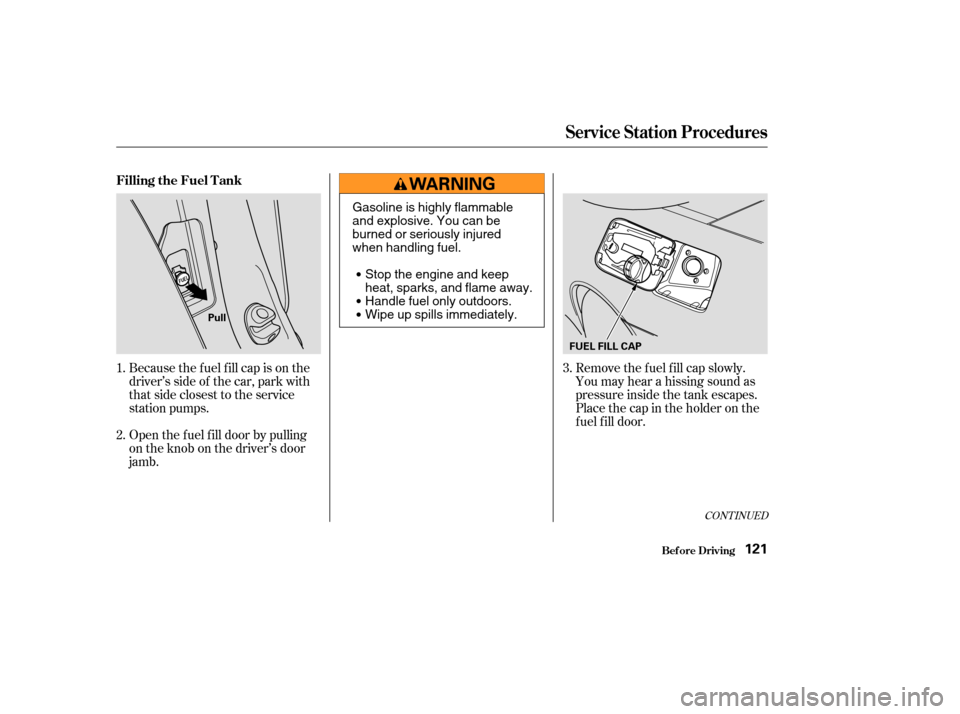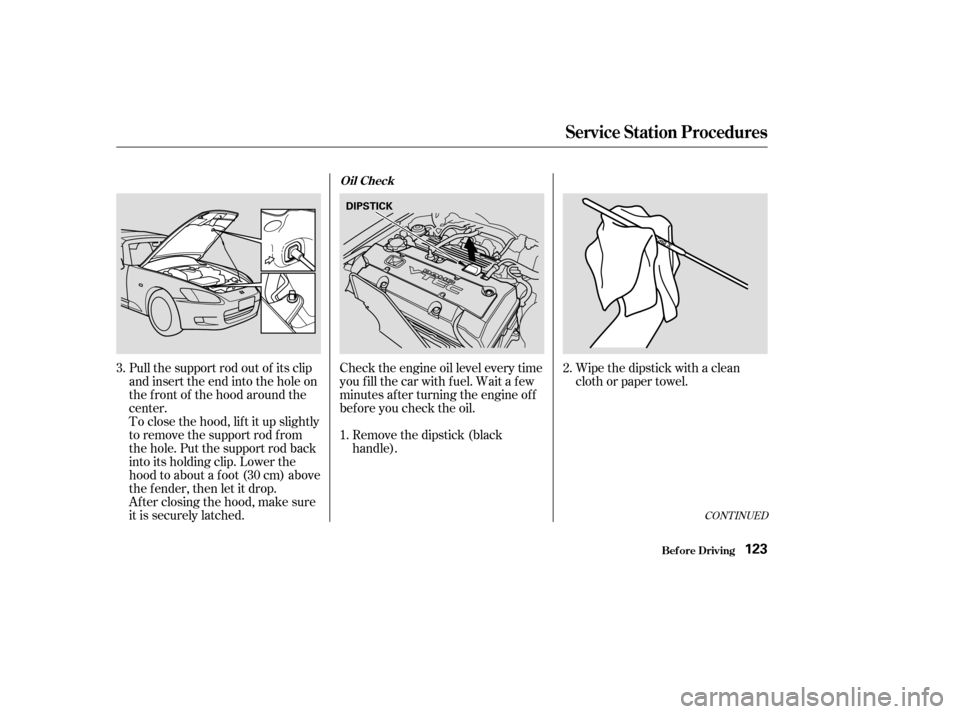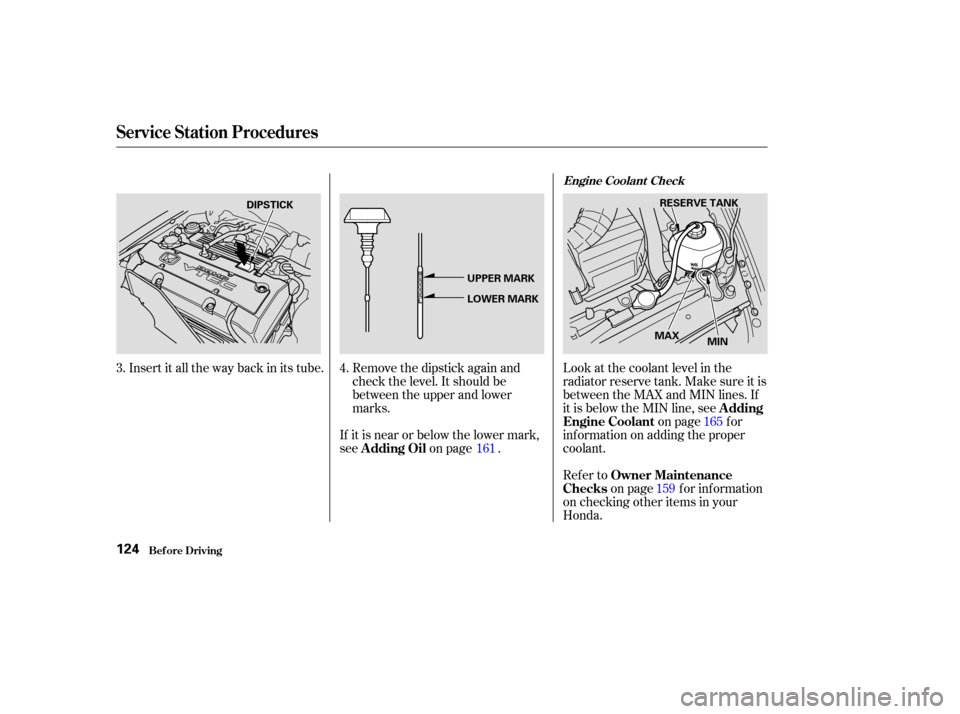engine HONDA S2000 2003 1.G Owner's Manual
[x] Cancel search | Manufacturer: HONDA, Model Year: 2003, Model line: S2000, Model: HONDA S2000 2003 1.GPages: 280, PDF Size: 3.9 MB
Page 122 of 280

Bef ore you begin driving your Honda,
youshouldknowwhatgasolineto
use, and how to check the levels of
important f luids. You also need to
know how to properly store luggage
or packages. The inf ormation in this
section will help you. If you plan to
add any accessories to your vehicle,
please read the inf ormation in this
section f irst..............................
Break-in Period .120
.........................................
Gasoline .120
.........
Service Station Procedures . 121
................
Filling the Fuel Tank . 121
....................
Opening the Hood .122
...............................
Oil Check .123
.........
Engine Coolant Check . 124
...............................
Fuel Economy .125
............................
Car Condition .125
...........................
Driving Habits .125
...
Accessories and Modif ications . 126
................................
Accessories .126
............................
Modif ications .127
...
Additional Safety Precaution . 127
.............................
Carrying Cargo .128
.....................
General Precautions .131
Bef ore Driving
Bef ore Driving119
Page 123 of 280

During this period:Avoid full-throttle starts and rapid
acceleration. Do not exceed
5,500 rpm f or the f irst 600 miles
(1,000 km) of operation.
Help assure your car’s f uture
reliability and perf ormance by paying
extra attention to how you drive
during the f irst 600 miles (1,000 km).
Using gasoline containing lead will
damage your car’s emissions
controls. This contributes to air
pollution.
In Canada, some gasolines contain
an octane-enhancing additive called
MMT. If you use such gasolines,
your emission control system
perf ormance may deteriorate and
the Malf unction Indicator Lamp on
your instrument panel may turn on.
If this happens, contact your
authorized Honda dealer f or service.
We recommend gasolines containing
detergent additives that help prevent
f uel system and engine deposits. If you are unable to f ind premium
unleaded gasoline, you may substi-
tute an unleaded regular gasoline.
The engine will compensate f or the
lower octane, but you may notice a
slight decrease in power as a result. Your Honda is designed to operate
on premium unleaded gasoline with a
pump octane number of 91 or higher. Youshouldfollowthesesamere-
commendations with an overhauled
or exchanged engine, or when the
brakes are relined.
Avoidhardbraking.Newbrakes
need to be broken-in by moderate
use f or the f irst 200 miles (300
km).
Do not change the oil until the
recommended time or mileage
intervalshowninthemaintenance
schedule.
Break-in Period
Gasoline
Bef ore Driving
Break-in Period, Gasoline
120
Page 124 of 280

Remove the f uel f ill cap slowly.
You may hear a hissing sound as
pressure inside the tank escapes.
Place the cap in the holder on the
fuel fill door.
Because the f uel f ill cap is on the
driver’s side of the car, park with
that side closest to the service
station pumps.
Open the f uel f ill door by pulling
on the knob on the driver’s door
jamb.
1.
2.
3.
CONT INUED
Filling the Fuel Tank
Service Station Procedures
Bef ore Driving121
Pull
FUEL FILL CAP
Gasoline is highly flammable
and explosive. You can be
burned or seriously injured
when handling fuel.Stop the engine and keep
heat, sparks, and flame away.
Handle fuel only outdoors.
Wipe up spills immediately.
Page 126 of 280

Pull the support rod out of its clip
and insert the end into the hole on
the f ront of the hood around the
center.
To close the hood, lif t it up slightly
to remove the support rod f rom
the hole. Put the support rod back
into its holding clip. Lower the
hood to about a f oot (30 cm) above
the fender, then let it drop.
After closing the hood, make sure
it is securely latched.Check the engine oil level every time
you f ill the car with f uel. Wait a f ew
minutes af ter turning the engine of f
bef ore you check the oil.
Remove the dipstick (black
handle). Wipe the dipstick with a clean
cloth or paper towel.
1.
3.
2.
CONT INUED
Oil Check
Service Station Procedures
Bef ore Driving123
DIPSTICK
Page 127 of 280

Insert it all the way back in its tube. Remove the dipstick again andcheck the level. It should be
between the upper and lower
marks.
If it is near or below the lower mark,
see on page . Look at the coolant level in the
radiator reserve tank. Make sure it is
between the MAX and MIN lines. If
it is below the MIN line, see
on page f or
inf ormation on adding the proper
coolant.
Refer to on page f or inf ormation
on checking other items in your
Honda.
3.
4.
161 159165
Service Station Procedures
Bef ore Driving
A dding Oil
A dding
Engine Coolant
Owner Maintenance
Checks
Engine Coolant Check
124
UPPER MARK
LOWER MARK
DIPSTICK
RESERVE TANK
MAX MIN
Page 128 of 280

You can improve f uel economy by
driving moderately. Rapid acceler-
ation, abrupt cornering, and hard
braking use more f uel.
Always drive in the highest gear that
allows the engine to run and acceler-
ate smoothly.
A cold engine uses more f uel than a
warm engine. It is not necessary to
‘‘warm-up’’ a cold engine by letting it
idle f or a long time. You can drive
away in about a minute, no matter
how cold it is outside. The engine
will warm up f aster, and you get
better f uel economy. To cut down on
the number of ‘‘cold starts,’’ try tocombine several short trips into one.
The condition of your car and your
driving habits are the two most
important things that affect the fuel
mileage you get.
Always maintain your car according
to the maintenance schedule. This
will keep it in top operating condition.
Depending on traf f ic conditions, try
to maintain a constant speed. Every
time you slow down and speed up,
your car uses extra f uel. Use the
cruise control, when appropriate, to
increase f uel economy.The air conditioning puts an extra
load on the engine which makes it
usemorefuel.Turnoff theA/Cto
cut down on air conditioning use.
Use the f low-through ventilation
when the outside air temperature is
moderate.
In winter, the build-up of snow on
your car’s underside adds weight and
rolling resistance. Frequent cleaning
helps your f uel mileage and reduces
thechanceof corrosion. An important part of that mainte-
nance is the (see page ). For
example, an underinf lated tire
causes more ‘‘rolling resistance,’’
which uses f uel. It also wears out
f aster, so check the tire pressure at
least monthly. 159 Driving Habits
Car Condition
Owner Maintenance
Checks
Bef ore Driving
Fuel Economy
125
Page 136 of 280

This section gives you tips on
starting the engine under various
conditions, and how to operate the
manual transmission. It also includes
important inf ormation on parking
your car, and the braking system.........................
Preparing to Drive .134
.......................
Starting the Engine .135
Starting in Cold Weather ....................
at High Altitude .136
....
6-speed Manual Transmission . 137
.....
Recommended Shif t Points . 138
..............
Engine Speed Limiter . 138
.......................
Reverse Lockout .138
...........................................
Parking .139
.....................
The Braking System .140
.............
Brake Wear Indicators . 140
...............
Brake System Design . 141
.......................
Anti-lock Brakes .141
Important Saf ety .........................
Reminders .142
........................
ABS Indicator .143
...............
Driving in Bad Weather . 144
...........................
Towing a Trailer .145
Driving
Driving133
Page 137 of 280

Make sure all windows, mirrors,
and outside lights are clean and
unobstructed. Remove f rost, snow,
or ice.Check that any items you may be
carrying with you inside are stored
properly or f astened down
securely.
Check the adjustment of the seat
(see page ).
Check the adjustment of the
inside and outside mirrors (see
page ).Fasten your seat belt. Check that
your passenger has f astened his or
her seat belt (see page ).
Turn the ignition switch ON (II).
Check the indicator lights in the
instrument panel.
Start the engine (see page ).
Check the gauges and indicator
lights in the instrument panel (see
page ).
Visually check the tires. If a tire
looks low, use a gauge to check its
pressure.
Youshoulddothefollowingchecks
and adjustments every day bef ore
you drive your car.
Check that the hood and trunk are
f ully closed. Make sure the doors are securely
closed and locked.
1.
2.
3. 4.
5.
6.
7.8.
9.
10.
11. 15
69
80 45135
Driving
Preparing to Drive
134
Page 138 of 280

Apply the parking brake.
In cold weather, turn of f all
electrical accessories to reduce
the drain on the battery.
Push the clutch pedal down all the
way. The ENGINE START button
has no ef f ect unless the clutch
pedal is depressed.
Turn the ignition key to ON (II)
position.Without touching the accelerator
pedal, push the ENGINE START
button. If the engine does not start
right away, do not hold the
ENGINE START button f or more
than 15 seconds at a time. Pause
f or at least 10 seconds bef ore
trying again.If the engine still does not start,
press the accelerator pedal all the
way down and hold it there while
starting in order to clear f looding.
As before, hold the ENGINE
START button f or no more than
15 seconds. Return to step 6 if the
engine does not start. If it starts,
lif t your f oot of f the accelerator
pedal so the engine does not race. If the engine does not start within
15 seconds, or starts but stalls
right away, repeat step 5 with the
accelerator pedal pressed half-way
down. If the engine starts, release
pressure on the accelerator pedal
so the engine does not race.
1.
2.
3.
4.
5.6.
7.
Driving
Starting the Engine
135
ENGINE START BUTTON
Page 139 of 280

An engine is harder to start in cold
weather. The thinner air f ound at
high altitude above 8,000 f eet
(2,400 meters) adds to the problem.Use the f ollowing procedure:
Turn of f all electrical accessories
to reduce the drain on the battery.
Push the accelerator pedal half-
way to the f loor and hold it there
while starting the engine. Do not
hold the ENGINE START button
formorethan15seconds.When
the engine starts, release the
accelerator pedal gradually as the
engine speeds up and smooths out.
If the engine fails to start in step 2,
push the accelerator pedal to the
f loor and hold it there while you
try to start the engine for no more
than 15 seconds. If the engine
does not start, return to step 2.
1.
2.
3.
Starting the Engine
Driving
Starting in Cold Weather at High
A ltitude (A bove 8,000 f eet/
2,400 meters)
136